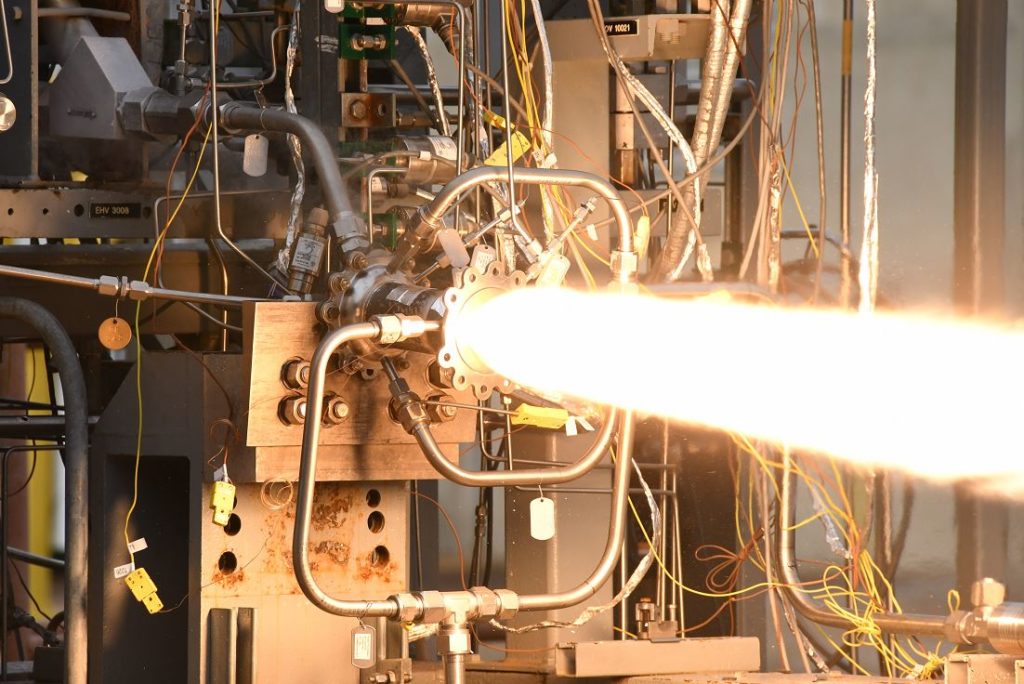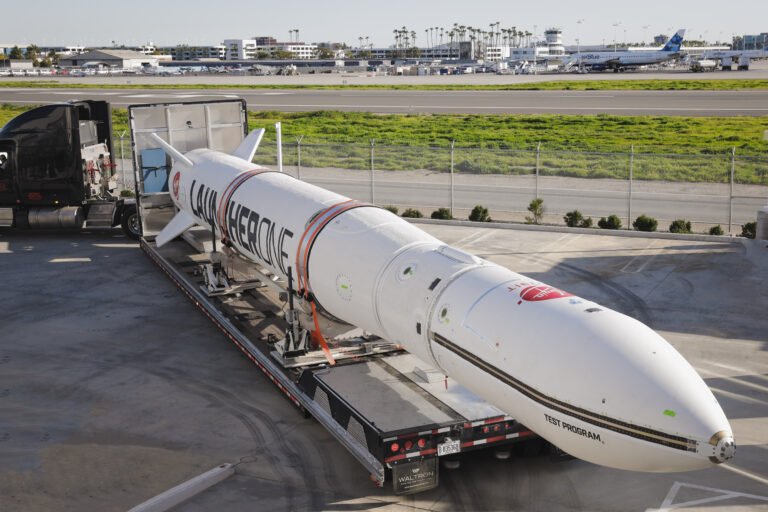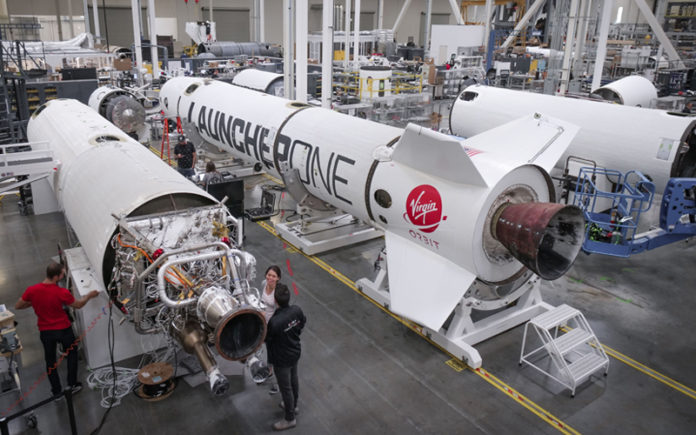With private companies at the forefront of recent space innovations, the space industry is undergoing a paradigm shift driven by disruptive market solutions’ offering and industrial approaches that were not often considered by governments. What is interesting in this new paradigm is that it opens up new doors for technological innovations and position space new entrants as experts across other vertical industries. In this vein, 3D ADEPT Media discusses the current use of additive manufacturing technologies at Virgin Orbit and some of the challenges the Space industry faces in the adoption of these technologies.
Three years ago, Virgin Orbit debuted on the very select small satellite business with the goal to provide the most flexible and responsive satellite launcher ever invented. To achieve this mission, the Virgin Group company had been working on a LauncherOne smallsat rocket, an air launch to orbit rocket, designed to take smallsat payloads of 300 kilograms (660 lb) and more into orbit.
After an unsuccessful first attempt, the space start-up finally lived up to its name since on January 17th 2021, it reached orbit, successfully deploying 10 CubeSats into Low Earth Orbit. The milestone was even important for the space expert as it was the first time it launched working satellites into space on behalf of NASA.
Although the successful launch is due to a technique called air launch**, it should be noted that if the provider of launch services for small satellites is becoming a high-profile pioneer of this new commercial space race, it is also because at the heart of some of its manufacturing projects, additive manufacturing has always been recognized as a key enabler.
“At Virgin Orbit, we aim to contribute to the future of humanity in space. We help our customers change the world by increasing the rates at which we make our rockets while reducing the cost per launch. To do so, we rely on advanced manufacturing techniques and technologies to manufacture propulsion components as well as other complex components that can be embedded in a rocket, Oluseun Taiwo, Propulsion Advanced Manufacturing Engineer, states from the outset.
Virgin Orbit first appeared in our radar when NASA Marshall Space Center announced that, together, they should explore multi-metal 3D printing to build multi-metallic combustion chambers.

The project was even more important for the team at Virgit Orbit, as information gained from this partnership would be key in applying AM “technologies to further improve cost, performance and lead time of [its] propulsion systems for the LauncherOne vehicle.”
Multi-metallic parts are a significant improvement in the production of rocket engine combustion chambers as they mainly address materials properties requirements (such as strength or thermal conductivity) – requirements that Virgin Orbit has been able to meet in this case using an in-house hybrid additive-subtractive manufacturing system.
This being said, we have noticed that Powder-bed fusion and DED AM technologies are also often very highlighted as one of the most used AM technologies in-house – especially for the production of intricate details and cooling channels into thrust chambers and injectors. When asked the reasons why they focused on these technologies, Taiwo replied:

“DED allows us to make massive parts very quickly. The deposition rates that you make on those machines are quite quick. It would be hard to find another AM process that can beat DED processes in terms of uniformity when it comes to production of massive parts. DED also allows us to create multi-material solutions for very hard processes. For instance, you can get a weight saving in some crucial parts while in others you can get some performance upgrades using this process.“
“Powder bed fusion on the other hand, allows for the creation of some intricate geometries in high quality, not to mention that it can also process a lot of materials. We often used this technology for the manufacturing of complex thrust chambers with cooling channels or turbo machinery. With thrust chambers that feature cooling channels for instance, it’s a great time saving to be able to manufacture such parts in one go”, the engineer explains.
The main complexities in the use of AM in space.
Low-cost satellites and lighter rockets are usually mentioned as one of the first AM applications in the space industry, but we are still far away from a “natural” utilization of AM. Indeed, engineers still have several manufacturing challenges to overcome.
For space ventures to easily launch satellites, probes telescopes or spacecraft in orbit, they need to address the high per kilogram cost required to break free of the Earth’s gravitational pull.
In other words, mission costs can be expedited by several orders of magnitude for every additional kilogram of payload. Weight is definitely the first challenge AM is uniquely positioned to overcome but others come inevitably into play.
According to Taiwo, materials uniformity is on top of the challenges space engineers usually meet during manufacturing. “We need to be able to produce repeatable propulsion or structural components which can be very complex depending on the manufacturing process used. Complexity relies on several factors and we should be able to capitalize on manufacturing and produce hardware that will not only work one time”, the engineer says.
Furthermore, as we saw in most industries, Taiwo outlines “Design for AM” as another complexity in the use of AM in the Space industry. Reality shows that space applications such as launchers and satellite systems are produced in small batches but they must cope with the extreme conditions and requirements of launching, not to mention that they can be used for more than 15 years after successful orbit insertion.
Unlike other industries, “metal AM is still in its infancy in this field. From an engineering design perspective, AM increases the opportunity to apply new software strategies such as topology optimization [as it offers the opportunity to manufacture with minimal weight by solving material distribution problems]. From a design perspective, we are not yet there. In general, space engineers are still trying to understand where they should push in their designs to better control the manufacturing process. However, I like the approach we have at Virgin Orbit, as we innovate as much as possible by asking questions and scrutinizing processes We bring technologies in-house and we spend time on development – and any time, there is a certain change, we are going to treat it as a whole new process. That conscious step, for some people, it does not work but for us, it does.”
This DfAM challenge in space applications has been confirmed with other space engineers. As a matter of fact, for most engineers, designing in additive manufacturing is difficult because it involves a process of unlearning the design guidelines from conventional manufacturing. Furthermore, existing AM processes reveal a variation in the printed products, which can vary from one part to another or from one machine to another.

There are several different approaches available for DfAM and as we understood from Taiwo’s comments, there is not yet a defined guideline that can be used by all companies. However, one method often used by designers is to define AM candidacy through the design analysis approach. This approach consists in identifying parts where AM could be applied efficiently by leveraging DfAM capabilities. Four criteria are often taken into consideration in this process: functions integration, customization, lightweight design as well as operation efficiency.
The user perspective vs the manufacturing perspective
As an early adopter of AM technologies in the space industry, Virgin Orbit is also uniquely positioned to raise some of the questions that still need to be discussed by AM vendors and AM service providers.
According to our guest, one of these concerns is the fact that, although AM is a very highly automated process, there are still features such as powder removal/parts cleaning that are not automated. Any space company that is looking to increase its production and launching pace will look for ways to control and automate this manufacturing stage.
As time is going by, the space sector will take an even more important place in the additive manufacturing industry. Virgin Orbit’s very strategic use of AM to provide launch services for small satellites is a good illustration of the way a space company can leverage these technologies. Whilst the development of combustion chambers and injectors by AM are very unique, the present story sheds light on some of the complexities that still need to be addressed at the manufacturing level; complexities that will certainly require further collaborations between AM technologies providers and space companies to enable further commercial launches.
**At the heart of Virgin Orbit’s successful launch is a technique called, air launch – that provides more versatility for space missions, since the carrier airplane can be based at any airport that has a runway long enough for takeoff. A technique, in a nutshell that improves the payload capacity of the rocket, and makes the LauncherOne system one of the most flexible and responsive launch service of the market.
This exclusive feature has first been published in the January/February issue of 3D ADEPT Mag.






